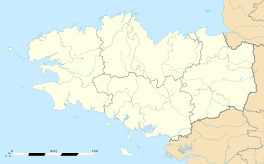Carnac
|
Carnac Karnag |
||
|---|---|---|

Standing stones in the Kermario alignment
|
||
|
||
| Coordinates: 47°35′05″N 3°04′46″W / 47.5847°N 3.0794°WCoordinates: 47°35′05″N 3°04′46″W / 47.5847°N 3.0794°W | ||
| Country | France | |
| Region | Brittany | |
| Department | Morbihan | |
| Arrondissement | Lorient | |
| Canton | Quiberon | |
| Intercommunality | Côte des Mégalithes | |
| Government | ||
| • Mayor (2008—2014) | Michel Grall | |
| Area1 | 32.71 km2 (12.63 sq mi) | |
| Population (1999)2 | 4,444 | |
| • Density | 140/km2 (350/sq mi) | |
| Time zone | CET (UTC+1) | |
| • Summer (DST) | CEST (UTC+2) | |
| INSEE/Postal code | 56034 /56340 | |
| Elevation | 0–45 m (0–148 ft) (avg. 16 m or 52 ft) |
|
|
1 French Land Register data, which excludes lakes, ponds, glaciers > 1 km² (0.386 sq mi or 247 acres) and river estuaries. 2Population without double counting: residents of multiple communes (e.g., students and military personnel) only counted once. |
||
1 French Land Register data, which excludes lakes, ponds, glaciers > 1 km² (0.386 sq mi or 247 acres) and river estuaries.
Carnac (Breton: Karnag) is a commune beside the Gulf of Morbihan on the south coast of Brittany in the Morbihan department in north-western France.
Its inhabitants are called Carnacois in French. Carnac is renowned for the Carnac stones – one of the most extensive Neolithic menhir collections in the world – as well as its beaches, which are popular with tourists.
Located on a narrow peninsula halfway between the medieval town Vannes and the seaside resort Quiberon, Carnac is split into two centres - Carnac-Ville and Carnac-Plage (the beachfront). In total there are five beaches, including la Grande Plage, and further to the east, Plage Men Dû and Beaumer.
Carnac is famous as the site of more than 10,000 Neolithic standing stones, also known as menhirs. The stones were hewn from local rock and erected by the pre-Celtic people of Brittany. Local tradition claims that the reason they stand in such perfectly straight lines is that they are a Roman legion turned to stone by Pope Cornelius.
The Carnac stones were erected during the Neolithic period which lasted from around 4500 BC until 2000 BC. The precise date of the stones is difficult to ascertain as little dateable material has been found beneath them, but the site's main phase of activity is commonly attributed to c. 3300 BC. One interpretation of the site is that successive generations visited the site to erect a stone in honour of their ancestors.
...
Wikipedia



